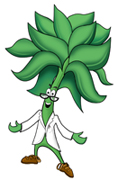Wireless Mesh Networks
October 2, 2014 06:00 AM

Wireless Mesh Networks
It seems that wireless networks are everywhere these days, whether cellular networks for phones, or Wi-Fi networks for laptops, tablets, and smartphones. For plants, wireless sensor networks are becoming more popular, and most sensor networks are mesh networks. But what is a mesh network?
Let’s start with what it’s not. A cellular network is not a mesh network.  If you call someone across the room from you, your phone does not talk directly to his, even though you are so close - both of your phones only talk to the cell tower, which passes your conversations back and forth. Communications are Point-to-Point (or more accurately, Point-to-Multipoint, since there are multiple cell phones using one tower). If those cell phones are replaced with radios that can talk to a central tower, and also can forward messages from radios that are too far away, then we have a Tree Network (although the network to the right looks more like a bush). In network terms, the red radio/tower is called the “hub”, and the blue radios are “nodes”. All the nodes can talk to the hub, but the further nodes need help from the ones colored dark blue to pass their messages on to the hub. A tree is the most efficient way for independent nodes to talk to a single hub.
If you call someone across the room from you, your phone does not talk directly to his, even though you are so close - both of your phones only talk to the cell tower, which passes your conversations back and forth. Communications are Point-to-Point (or more accurately, Point-to-Multipoint, since there are multiple cell phones using one tower). If those cell phones are replaced with radios that can talk to a central tower, and also can forward messages from radios that are too far away, then we have a Tree Network (although the network to the right looks more like a bush). In network terms, the red radio/tower is called the “hub”, and the blue radios are “nodes”. All the nodes can talk to the hub, but the further nodes need help from the ones colored dark blue to pass their messages on to the hub. A tree is the most efficient way for independent nodes to talk to a single hub.
Back to your conversation with your friend. If you were using walkie-talkie radios, the radios would be communicating directly with each other (as well as to anyone else within range with a similar radio). Each radio on the network can talk to every other one that’s within range. Mesh networks are like this, with the same enhancement that tree networks have – each node can forward messages from further-away nodes.
But why do wireless sensors usually use mesh networks? Plant sensors are independent of each other. They each need to send their data to a hub that gathers the data and logs or forwards it. So why don’t they use a tree network?
 A tree network requires a trained technician to configure it, tune it, and maintain it. A mesh network doesn’t. To the left are the same sensor nodes as before, but now using mesh radios at each node. Both the solid and dotted lines represent communication paths. Initially each sensor node will try all the paths to get their data to the hub. But they will quickly learn the fastest route and begin using the solid lines – forming a tree network - without needing to be configured. And if a truck parks between two radios, blocking the communications path, the radios will find another path and use it until the truck moves – all without human intervention.
A tree network requires a trained technician to configure it, tune it, and maintain it. A mesh network doesn’t. To the left are the same sensor nodes as before, but now using mesh radios at each node. Both the solid and dotted lines represent communication paths. Initially each sensor node will try all the paths to get their data to the hub. But they will quickly learn the fastest route and begin using the solid lines – forming a tree network - without needing to be configured. And if a truck parks between two radios, blocking the communications path, the radios will find another path and use it until the truck moves – all without human intervention.
Due to the mesh network’s ease of installation and maintenance, many operations are taking advantage of this type of a sensor network to gather crucial plant and crop data in many locations across their operation.

All the best,

Related Links:
WatchDog Retriever and Pup Mesh Network and SpecConnect Web Portal - Coming Soon
Back